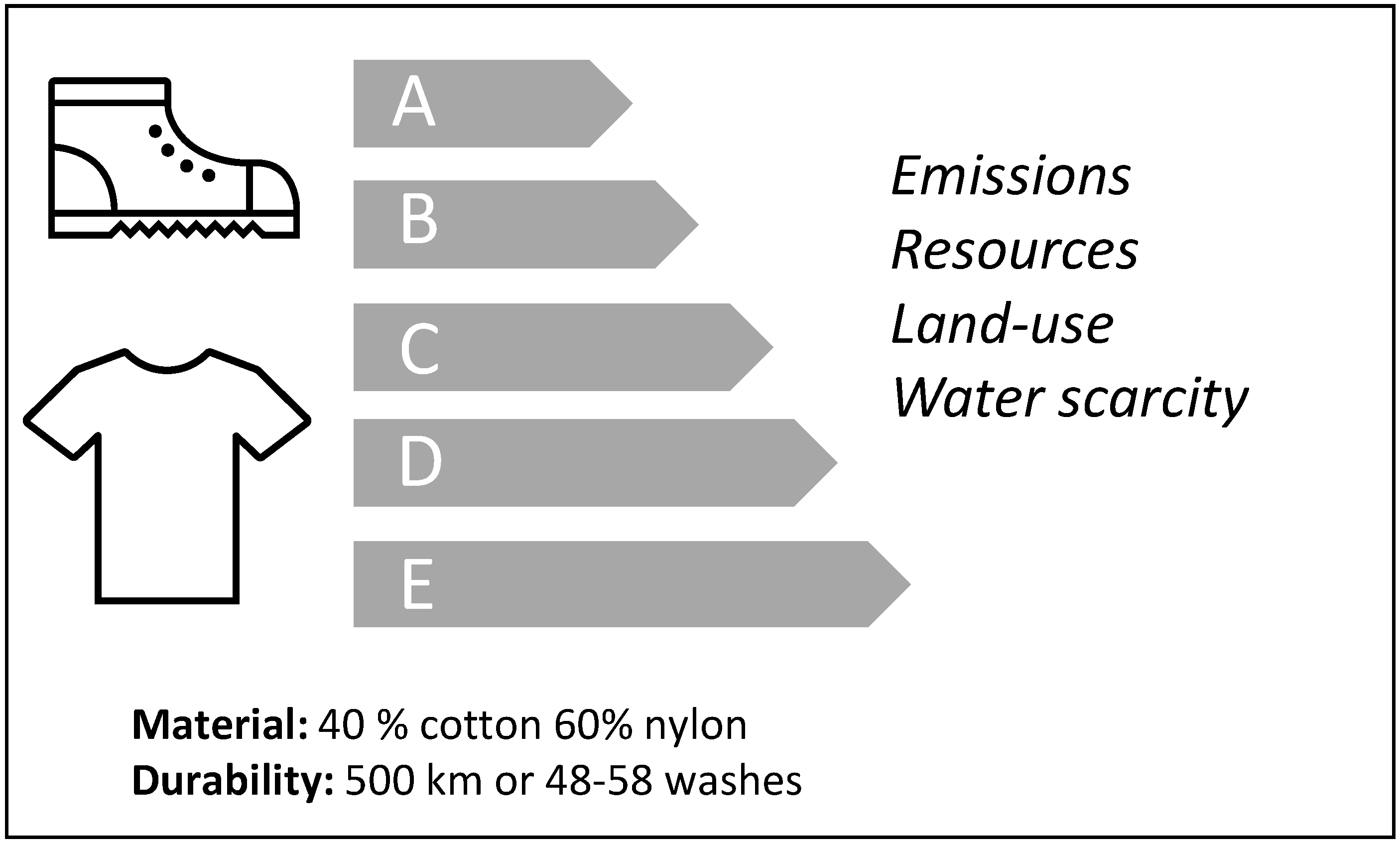Looking for Sustainability Scoring in Apparel: A Review on Environmental Footprint, Social Impacts and Transparency
Abstract
:1. Introduction
- RQ1: Has research been conducted regarding the application of environmental life cycle analysis (e-LCA) and social life cycle analysis (s-LCA) to the apparel multi-layer supply chain?
- RQ2: How is the industry tackling environmental, social, and transparency sustainability issues?
- RQ3: What are the existing KPI, labelling, and third-party certification schemes?
- RQ4: How do end-users (consumers) perceive sustainability in fashion, and how can KPIs be used to compare the same fashion product “type” (e.g., t-shirt A and t-shirt B with the same shape and color) in a credible, quantitative, and transparent manner to help consumers make an informed decision and avoid “green washing”.
2. Materials and Methods
- RQ1: Has research been conducted regarding the application of e-LCA and s-LCA to the apparel multi-layer supply chain?
- RQ2: How is industry tackling environmental, social, and transparency sustainability issues?
- RQ3: What are the existing KPI, labelling, and third-party certification schemes?
- RQ4: How do end-users (consumers) perceive sustainability in fashion, and how can KPIs be used to compare the same fashion product “type” (e.g., t-shirt A and t-shirt B with the same shape and color) in a credible, quantitative, and transparent manner to help consumers make an informed decision and avoid “green washing”.
2.1. RQ1: Has Research Been Conducted Regarding the Application of e-LCA and s-LCA to the Apparel Multi-Layer Supply-Chain?
| Reference | Context | Boundary (see Figure 4) | Total Impact Category w/ Climate Change | CO2eq w/o Use and EoL | Difference w/ Use and EoL |
|---|---|---|---|---|---|
| [23] | Research | #1; #2; #4 (1, 9, 10); #5; #6 (1). | 1 | 23 kgCO2eq/wool knit sweater; 7kgCO2eq/polyester knit shirt; 8kgCO2eq/cotton knit shirt | +18 kgCO2eq/wool knit sweater; +21kgCO2eq/polyester knit shirt; +21kgCO2eq/cotton knit shirt; |
| [24] | Research | #1; #2 (1–6); #4 (1–6, 11); #5 (1); #6 (1) | 4 | Conventional t-shirt 18 kgCO2eq/kg apparel | +21 kgCO2eq/kg apparel |
| [25] | Research | #1; #2 (1–6); #4 (1); #5 (1–2); #6 (1) | 20 | Cotton 23 kgCO2eq/kg knitted fabric; Acryl 16 kgCO2eq/kg knitted fabric; Nylon 22 kgCO2eq/kg knitted fabric; PET 16 kgCO2eq/kg knitted fabric; elastan 18 kgCO2eq/kg knitted fabric | −0.60 kg CO2 equivalent/kg for cotton |
| [26] | Research | #1; #2; #3 (2) #4 w/o (7–9, 11) #5; #6 (1) | 10 | 5 kg CO2eq/t-shirt | +1 kgCO2eq/t-shirt |
| [27] | Research | #1; #2; #3 (2); #4 (w/o 7–11); #5 | 9 | 22 kgCO2eq/sweater (cotton) 12 kgCO2eq/sweater (wool) 24 kgCO2eq/sweater (blend) 55 kgCO2eq/sweater (acrylic) | +28 kgCO2eq/sweater (100% cotton); +10 kgCO2eq/sweater (100% wool); +38 (blend); +31 kgCO2eq/sweater |
| [28] | Research | #1; #2; #4 w/o (7–9, 11); #5 (1, 2); #6 (1, 4) | 7 | 2.55 kgCO2eq/t-shirt (triclosan); 2.7 kgCO2eq/t-shirt (nanosilver–FSP) 7.67 kg CO2eq/t-shirt (nanosilver–PlaSpu) | |
| Research | #1, #2, #4 w/o (7–9, 11), #6 (1, 2, 4) | 7 | 2 kg CO2eq/pair | +0.5 kg CO2eq/pair | |
| PEF t-shirt [15,29] | Research and industry | #1; #2; #3; #4; #5; #6 | 16 | 5.43 -3.18 kg CO2eq/t-shirt (33.9 kg CO2eq/kg Men Tshirt-42.4 kg CO2eq/kg baby t-shirt) | +0.85 kg CO2eq/man t-shirt, +0.44 kg CO2eq/baby t-shirt (+5.3 kg CO2eq/kg man t-shirt, +5.87 kg CO2eq/kg baby t-shirt) |
| PEF footwear [11,15] | Research and industry | #1; #2; #3; #4 (w/o 11); #6 (1, 4) | 16 | 5.23–14.9 kg CO2eq/pair | NA |
| [30] | Research and industry | #1; #2 (2); #3 (2); #4 (1–6) (9–11); #5; #6 (1) | 12 | 17–2 kg CO2eq/garment | Credits for incineration w/ energy recovery compensate the usage burden |
| Nudie Jeans [31] | Research/Industry | #1; #2; #3; #4 (1–6, 10); #5 (1, 2); #6 (1) | 18 | 4.0 kg CO2eq/jeans (0 reuse) to 2 kg CO2eq/jeans (3 reuses) | +0.5 kg CO2eq/jeans |
| GORE [32] | Industry | #1; #2; #4 (9, 10); #5 (1); #6 (1) | 18 | 47 kg CO2eq/1 jacket | +25.3 kg CO2eq |
| Levi Strauss & Co [21] | Industry | #1; #2; #3; #4; #5; #6 | 6 | 20 kg CO2eq/pair jeans | +13.4 kg CO2eq/pair jeans |
2.2. RQ2: How Is Industry Tackling Environmental, Social, and Transparency Sustainability Issues?
2.2.1. International Standards with Generic Application in Industry
2.2.2. Higg Index (Created by the Apparel Industry for the Apparel Industry)
2.2.3. Fashion Transparency Index (Created by Activist Organization to Apparel Industry)
2.2.4. Environmental Profit and Loss (EP&L) Open Methodology (Created by the Apparel Industry for the Apparel Industry)
- Climate change related: Leather product environmental footprint.
- Air quality related: To improve the understanding of human exposure to air pollutants, meteorological data used in pollution dispersion models are updated and collected for more locations.
- Land use related: The soil organic carbon content of soil under different farming practices is included as a proxy for ecosystem services values. Metrics used are above-ground biomass, species richness, and soil organic carbon (SOC).
- Waste production related: Data on quality and type of waste treatment facility is updated to better reflect the likely impacts of non-recycled waste.
- Water consumption related: To improve the correlation between corporate or agricultural water consumption and the prevalence of waterborne diseases in water stressed areas, the applied statistical approach is updated.
- Water pollution related: The latest version of the USEtox database is used as the basis for estimating the quantity of water pollutants that are likely to affect the human population.
2.2.5. Apparel Industry Reality (Top 10 Retailers)
2.3. RQ3 What Are the Existing KPI, Labelling, and Third-Party Certification Schemes?
2.4. RQ4: How Do End-Users (Consumers) Perceive Sustainability in Fashion, and How Can KPIs Be Used to Compare the Same Fashion Product “Type” (e.g., t-Shirt A and t-Shirt B with the Same Shape and Color) in a Credible, Quantitative, and Transparent Manner to Help Consumers Make an Informed Decision and Avoid “Green Washing”
3. Answers to Research Questions and Sustainability Criteria Checklist
4. Conclusions
Supplementary Materials
Author Contributions
Funding
Acknowledgments
Conflicts of Interest
Nomenclature
| ACSI | American Customer Satisfaction Index |
| ADP | Abiotic resource depletion potential |
| AP | Acidification potential |
| B2B | Business to Business |
| B2C | Business to Consumer |
| BCI | Better Cotton Initiative |
| BSCI | Business Social Compliance Initiative |
| BRM | Brand & Retail Model |
| BREEAM | Building Research Establishment Environmental Assessment Method |
| CEO | Chief Executive Officer |
| CoC | Code of Conduct |
| CO2eq | Carbon dioxide equivalents |
| CPSA | Consumer Product Safety Act |
| CPSIA | Consumer Product Safety Improvement Act |
| EC | Energy consumption or European Commission |
| KPI | Key Performance Indicator |
| e-LCA | Environmental Life Cycle Assessment/Analysis |
| EMAS | Eco-Management and Audit Scheme |
| EoL | End of Life |
| EP&L | Environmental Profit and Loss |
| ESP | Spain |
| EU | European Union |
| EVA | Ethylene-vinyl acetate |
| FAETP | Fresh Aquatic Eco-Toxicity Potential |
| FEM | Facility Environmental model (Higg index) |
| FRA | France |
| FSC | Forest Stewardship Council |
| FSLM | Facility Social & Labor Module (Higg index) |
| FU | Functional Unit |
| GBR | Great Britain |
| GHG | Greenhouse Gas |
| GOTS | Global Organic Textile standard |
| GRI | Global Sustainability Reporting Initiative |
| GWP | Global Warming Potential |
| HTP | Human Toxicity Potential |
| ICS | Initiative for Compliance and Sustainability |
| ILO | International Labor Organization |
| ISO | International Standard Organization |
| JPN | Japan |
| LCA | Life cycle analysis/ life cycle assessment |
| LED | Light-Emitting Diodes |
| LEED | Leadership in Energy and Environmental Design |
| MAW | Minimal Acceptable Wage |
| NGO | Non-Governmental Organization |
| OECD | Organization for Economic Cooperation and Development |
| OSH | Occupational Safety and Health |
| PEF | Product Environmental Footprint |
| PEFC | Program for the Endorsement of Forest Certification |
| PETA | People for the Ethical Treatment of Animals |
| PM | Product Module (Higg index) |
| POCP | Photochemical oxidant creation potential |
| PSILCA | Product Social Impact Life Cycle Assessment database |
| REACH | Registration, Evaluation, Authorization and Restriction of Chemicals |
| RFID | Radio Frequency Identification System |
| RWS | Responsible Wool Standard |
| SAC | Sustainable Apparel Coalition |
| SDG | United Nations Sustainable Development Goals |
| s-LCA | Social Life Cycle Assessment/Analysis |
| SMETA | Sedex Members Ethical Trade Audits |
| SWE | Sweden |
| T&A | Textile and Apparel |
| UNGP | United Nations Guiding Principles |
| UK | United Kingdom |
| USA | United States of America |
| UNSDG | United Nations Sustainable Development Goals |
| WALDB | World Apparel and footwear LCA Database |
| ZDHC | Zero Discharge of Hazardous Chemicals |
References
- WCED Brutland Report: Our Common Future. 1987. Available online: https://www.are.admin.ch/are/en/home/sustainable-development/international-cooperation/2030agenda/un-_-milestones-in-sustainable-development/1987--brundtland-report.html (accessed on 15 April 2021).
- United Nations. The Sustainable Development Goals Report 2019. United Nations Publ. issued by Dep. Econ. Soc. Aff. 2019. Available online: https://unstats.un.org/sdgs/report/2019/The-Sustainable-Development-Goals-Report-2019.pdf (accessed on 15 April 2021).
- Fonseca, L.M.; Domingues, J.P.; Dima, A.M. Mapping the Sustainable Development Goals Relationships. Sustainability 2020, 12, 3359. [Google Scholar] [CrossRef] [Green Version]
- Pradhan, P.; Costa, L.; Rybski, D.; Lucht, W.; Kropp, J.P. A Systematic Study of Sustainable Development Goal (SDG) Interactions. Earth’s Future 2017, 5, 1169–1179. [Google Scholar] [CrossRef] [Green Version]
- Joy, A.; Sherry, J.F.; Venkatesh, A.; Wang, J.; Chan, R. Fast fashion, sustainability, and the ethical appeal of luxury brands. Fash. Theory 2012. [Google Scholar] [CrossRef]
- Ellen MacArthur Foundation. Accelerating the scale-up across global supply chains. In Towards the Circular Economy; Ellen MacArthur Foundation: Cowes, UK, 2014; Volume 3, pp. 1–64. [Google Scholar] [CrossRef] [Green Version]
- Dangelico, R.M.; Pujari, D. Mainstreaming green product innovation: Why and how companies integrate environmental sustainability. J. Bus. Ethics 2010, 95, 471–486. [Google Scholar] [CrossRef]
- Freise, M.; Seuring, S. Social and environmental risk management in supply chains: A survey in the clothing industry. Logist. Res. 2015, 8, 2. [Google Scholar] [CrossRef] [Green Version]
- Arena, M.; Ciceri, N.D.; Terzi, S.; Bengo, I.; Azzone, G.; Garetti, M. A state-of-the-art of industrial sustainability: Definitions, tools and metrics. Int. J. Prod. Lifecycle Manag. 2009, 4. [Google Scholar] [CrossRef]
- Raut, R.; Gardas, B.B.; Narkhede, B. Ranking the barriers of sustainable textile and apparel supply chains. Benchmark. Int. J. 2019, 26, 371–394. [Google Scholar] [CrossRef]
- Lu, L.; Bock, D.; Joseph, M. Green marketing: What the Millennials buy. J. Bus. Strategy 2013, 34, 3–10. [Google Scholar] [CrossRef]
- Correia, G.N.; Batista, T.P.; Marques, S.S.; Silva, C.M. How car material life-cycle emissions are considered in environmental rating methodologies? Suggestion of expedite models and discussion. Renew. Sustain. Energy Rev. 2014, 38, 20–35. [Google Scholar] [CrossRef]
- De Temmerman, J.; Heeremans, E.; Slabbinck, H.; Vermeir, I. The impact of the Nutri-Score nutrition label on perceived healthiness and purchase intentions. Appetite 2021, 157, 104995. [Google Scholar] [CrossRef]
- Kareiva, P.M.; McNally, B.W.; McCormick, S.; Miller, T.; Ruckelshaus, M. Improving global environmental management with standard corporate reporting. Proc. Natl. Acad. Sci. USA 2015, 112, 7375–7382. [Google Scholar] [CrossRef] [PubMed] [Green Version]
- Gül, S.; Spielmann, M.; Lehmann, A.; Eggers, D.; Bach, V.; Finkbeiner, M. Benchmarking and environmental performance classes in life cycle assessment—Development of a procedure for non-leather shoes in the context of the Product Environmental Footprint. Int. J. Life Cycle Assess. 2015, 20, 1640–1648. [Google Scholar] [CrossRef]
- Thinkstep First Draft Report Product Environmental Footprint Category Rules (PEFCR). 2020. Available online: https://ec.europa.eu/environment/eussd/smgp/pdf/PEFCR_guidance_v6.3.pdf (accessed on 15 April 2021).
- Choi, T.-M.; Li, Y. Sustainability in Fashion Business Operations. Sustainability 2015, 7, 15400–15406. [Google Scholar] [CrossRef] [Green Version]
- ISO 14044:2006 Environmental Management—Life Cycle Assessment—Requirements and Guidelines; International Organization for Standardization: Geneva, Switzerland, 2006; Available online: https://www.iso.org/standard/38498.html (accessed on 15 April 2021).
- Karthik, T.; Gopalakrishnan, D. Environmental Analysis of Textile Value Chain: An Overview. In Roadmap to Sustainable Textiles and Clothing. Textile Science and Clothing Technology; Muthu, S., Ed.; Springer: Singapore, 2014; pp. 153–188. ISBN 978-981-287-109-1. [Google Scholar]
- Elsen, M.; van Giesen, R.; van den Akker, A.D.K. Consumer Testing of Alternatives for Communicating the Environmental Footprint Profile of Products. 2019. Available online: https://ec.europa.eu/environment/eussd/smgp/pdf/2019_EF_commtest_report.pdf (accessed on 15 April 2021).
- Levi Strauss & Co. The Life Cycle Understanding the Environmental Impact of a Pair of Levi’s® 501 Jeans. 2015. Available online: https://www.levistrauss.com/wp-content/uploads/2015/03/Full-LCA-Results-Deck-FINAL.pdf (accessed on 15 April 2021).
- GORE-TEX. Available online: https://www.gore-tex.com/pressroom/press-release/responsibility-sustainability/life-cycle-assessment-study-shows-dwr-performance-during-use-phase-can-significantly-impact-its-environmental-profile (accessed on 15 April 2021).
- Moazzem, S.; Daver, F.; Crossin, E.; Wang, L. Assessing environmental impact of textile supply chain using life cycle assessment methodology. J. Text. Inst. 2018, 109. [Google Scholar] [CrossRef] [Green Version]
- Baydar, G.; Ciliz, N.; Mammadov, A. Life cycle assessment of cotton textile products in Turkey. Resour. Conserv. Recycl. 2015, 104, 213–223. [Google Scholar] [CrossRef]
- Van Der Velden, N.M.; Patel, M.K.; Vogtländer, J.G. LCA benchmarking study on textiles made of cotton, polyester, nylon, acryl, or elastane. Int. J. Life Cycle Assess. 2014, 19, 331–356. [Google Scholar] [CrossRef]
- Zhang, Y.; Liu, X.; Xiao, R.; Yuan, Z. Life cycle assessment of cotton T-shirts in China. Int. J. Life Cycle Assess. 2015, 20, 994–1004. [Google Scholar] [CrossRef]
- Nolimal, S. Life Cycle Assessment of Four Different Sweaters. DePaul Discov. 2018, 7, 9. [Google Scholar]
- Walser, T.; Demou, E.; Lang, D.J.; Hellweg, S. Prospective Environmental Life Cycle Assessment of Nanosilver T-Shirts. Environ. Sci. Technol. 2011, 45, 4570–4578. [Google Scholar] [CrossRef]
- Pesnel, S.; Payet, J. Product Environmental Footprint Category Rules (PEFCR) T-Shirts. 2019. Available online: https://ec.europa.eu/environment/eussd/smgp/pdf/PEFCR_tshirt.pdf (accessed on 15 April 2021).
- Roos, S.; Sandin, G.; Zamani, B.; Greg, P. Environmental Assessment of Swedish Fashion Consumption. 2015. Available online: http://mistrafuturefashion.com/wp-content/uploads/2015/06/Environmental-assessment-of-Swedish-fashion-consumption-LCA.pdf (accessed on 15 April 2021).
- Nellström, M.; Saric, M. A Comparative Life Cycle Assessment of Nudie Jeans’ Repair and Reuse Concept. Master’s Thesis, Chalmers University of Technology, Gothenburg, Sweden, 2019. [Google Scholar]
- Gore Life Cycle Assessment of a GORE Branded Waterproof, Windproof and Breathable Jacket. 2013. Available online: https://www.gore-tex.com/sites/default/files/assets/Gore_LCA_summary_report.pdf (accessed on 15 April 2021).
- Benoît, C.; Norris, G.A.; Valdivia, S.; Ciroth, A.; Moberg, A.; Bos, U.; Prakash, S.; Ugaya, C.; Beck, T. The guidelines for social life cycle assessment of products: Just in time! Int. J. Life Cycle Assess. 2010, 15, 156–163. [Google Scholar] [CrossRef]
- United Nations Environment Programme. Setac Life Cycle Initiative. In Guidelines for Social Life Cycle Assessment of Products; UNEP: Nairobi, Kenya, 2009; Volume 15, ISBN 9789280730210. [Google Scholar]
- Norris, C. Data for Social LCA. Int. J. Life Cycle Assess. 2014, 19, 261–265. [Google Scholar] [CrossRef] [Green Version]
- Norris, C.B.; Norris, G.A. Chapter 8: The Social Hotspots Database Context of the SHDB. Sustain. Pract. Guid. Soc. Anal. Assess. 2015, 1, 52–73. [Google Scholar]
- Eisfeldt, F. PSILCA–A Product Social Impact Life Cycle Assessment Database—Database Version 2.1. 2017. Available online: https://www.openlca.org/wp-content/uploads/2017/12/PSILCA_documentation_update_PSILCA_v2_final.pdf (accessed on 15 April 2021).
- Herrera Almanza, A.M.; Corona, B. Using Social Life Cycle Assessment to analyze the contribution of products to the Sustainable Development Goals: A case study in the textile sector. Int. J. Life Cycle Assess. 2020, 25, 1833–1845. [Google Scholar] [CrossRef]
- Vogtländer, J.G.; Brezet, H.C.; Hendriks, C.F. The virtual eco-costs ‘99 A single LCA-based indicator for sustainability and the eco-costs-value ratio (EVR) model for economic allocation. Int. J. Life Cycle Assess. 2001, 6, 157–166. [Google Scholar] [CrossRef]
- Van der Velden, N.M.; Vogtländer, J.G. Monetisation of external socio-economic costs of industrial production: A social-LCA-based case of clothing production. J. Clean. Prod. 2017, 153, 320–330. [Google Scholar] [CrossRef]
- Laurenti, R.; Moberg, Å.; Stenmarck, Å. Calculating the pre-consumer waste footprint: A screening study of 10 selected products. Waste Manag. Res. J. Sustain. Circ. Econ. 2017, 35, 65–78. [Google Scholar] [CrossRef] [PubMed]
- GRI G4 Sustainability Reporting Guidelines—Part 1: Reporting Principles and Standard Disclosures. Global Reporting Initiative 2013. Available online: https://www.globalreporting.org/resourcelibrary/G3-Guidelines-Incl-Technical-Protocol.pdf (accessed on 15 April 2021).
- GRI GRI G4 Guidelines and ISO 26000:2010—How to Use the GRI G4 Guidelines and ISO 26000 in Conjunction. Available online: http://www.iso.org/iso/iso-gri-26000_2014-01-28.pdf (accessed on 15 April 2021).
- Billet, P. De la loi Grenelle 1 à la loi Grenelle 2. Rev. Jurid. l’Environ. 2010. [Google Scholar] [CrossRef]
- Ministère de l’Ecologie du Développement Durable et de l’Energie Le Grenelle Environnement. 2010. Available online: https://www.doubs.gouv.fr/content/download/9112/55513/file/Hors_Serie_Grenelle_2_juillet_2010_cle5d1121-1.pdf (accessed on 15 April 2021).
- ISO 14001: Environmental Management Systems—Requirements with Guidance for Use; International Organization for Standardization: Geneva, Switzerland, 2015; Available online: https://www.iso.org/standard/60857.html (accessed on 15 April 2021).
- Freimann, J.; Walther, M. The impacts of corporate environmental management systems: A comparison of EMAS and ISO 14001. Greener Manag. Int. 2001. [Google Scholar] [CrossRef] [Green Version]
- United Nations. Guiding Principles on Business and Human Rights Guiding Principles on Business and Human Rights. 2011. Available online: https://www.ohchr.org/Documents/Publications/GuidingPrinciplesBusinessHR_EN.pdf (accessed on 15 April 2021).
- Miller, G.; Kędzierska, D.; Ordyńska, K. Ethical and Social Standards Are the Pathway for Small and Medium Enterprises to Collaborate with Large Clients. 2018. Available online: https://www.abris-capital.com/wp-content/uploads/2020/09/Ethical-and-social-standards.pdf (accessed on 15 April 2021).
- Ethical Trading Initiative The ETI Base Code. 2018. Available online: https://www.ethicaltrade.org/sites/default/files/shared_resources/ETI%20Base%20Code%20%28English%29.pdf (accessed on 15 April 2021).
- Amfori BSCI Code of Conduct 1. 2017. Available online: https://www.amfori.org/content/bsci-code-conduct (accessed on 15 April 2021).
- Sedex. Sedex Members Ethical Trade Audit (SMETA) Measurement Criteria. 2019. Available online: https://www.sedex.com/wp-content/uploads/2019/05/SMETA-6.1-Measurement-Criteria.pdf (accessed on 15 April 2021).
- ICS Initiative for Compliance and Sustainability. Available online: https://ics-asso.org/ (accessed on 12 September 2020).
- Global Value. Available online: www.global-value.eu (accessed on 23 July 2020).
- Sustainable Apparel Coalition The Sustainable Apparel Coalition. Available online: https://apparelcoalition.org/ (accessed on 30 August 2020).
- Olowu, T.O.; Sundararajan, A.; Moghaddami, M.; Sarwat, A.I.; Unigwe, O.; Okekunle, D.; Kiprakis, A.; Latif, A.; Gawlik, W.; Palensky, P.P. Higg Materials Sustainability Index (MSI) Methodology. 2020. Available online: https://howtohigg.org/wp-content/uploads/2020/07/Higg-MSI-Methodology-July-31-2020.pdf (accessed on 15 April 2021).
- Sustainable Apparel Coalition Higg Product Module (PM) Methodology. 2020. Available online: https://www.rse-et-ped.info/wp-content/uploads/2018/04/SAC-Overview-RSEPED.pdf (accessed on 15 April 2021).
- Sphera Solutions. GaBi Database. Available online: http://www.gabi-software.com (accessed on 13 October 2020).
- Chrobot, P.; Faist, M.; Gustavus, L.; Martin, A.; Stamm, A.; Zah, R.; Zollinger, M. Measuring Fashion: Insights from the Environmental Impact of the Global Apparel and Footwear Industries Study. 2018. Available online: https://refashion.fr/eco-design/sites/default/files/fichiers/Measuring%20Fashion%20Environmental%20Impact%20of%20the%20Global%20Apparel%20and%20Footwear%20Industries%20Study.pdf (accessed on 15 April 2021).
- Quantis World Apparel & Footwear Database (WALDB). Lausanne—Zürich—Paris—Montreal—Boston. 2016. Available online: https://www.aramis.admin.ch/Default?DocumentID=61255&Load=true (accessed on 15 April 2021).
- Sustainable Apparel Coalition The Higg Index. Available online: https://apparelcoalition.org/the-higg-index/ (accessed on 19 September 2020).
- Kering. Kering Standards for Raw Materials and Manufacturing Processes. 2020. Available online: https://www.kering.com/en/news/kering-open-sources-new-suite-of-industry-leading-standards (accessed on 15 April 2021).
- PricewaterhouseCoopers LLP Valuing Corporate Environmental Impacts-PwC Methodology Document. 2015. Available online: https://capitalscoalition.org/valuing-corporate-environmental-impacts-pwc-methodology-document/ (accessed on 15 April 2021).
- Deloitte Global Powers of Retailing 2020. Available online: https://www2.deloitte.com/content/dam/Deloitte/at/Documents/consumer-business/at-global-powers-retailing-2020.pdf (accessed on 15 April 2021).
- Nike Purpose Moves US. 2019-Inc. Impact Report. Available online: https://purpose.nike.com/ (accessed on 20 October 2020).
- TJX. 2019 Global Corporate Sustainability Report. 2019. Available online: https://www.tjx.com/docs/default-source/corporate-responsibility/tjx-2019-global-corporate-responsibility-report.pdf (accessed on 20 October 2020).
- H&M Group. Sustainability Performance Report 2019. Available online: https://hmgroup.com/wp-content/uploads/2020/10/HM-Group-Sustainability-Performance-Report-2019.pdf (accessed on 15 April 2021).
- Ross Stores, Inc. Corporate Social Responsibility. 2018. Available online: https://corp.rossstores.com/media/53058/ross_csr_overview_2019.pdf (accessed on 15 April 2021).
- LBrands. LBrands Responsability. Available online: https://www.lb.com/responsibility (accessed on 5 July 2020).
- Kering Group. Sustainability Progress Report 2017–2020. 2020. Available online: https://www.kering.com/en/sustainability/crafting-tomorrow-s-luxury/2017-2025-roadmap/progress-report-2017-2020/ (accessed on 15 April 2021).
- Inditex Anual Report 2019. Available online: https://www.inditex.com/investors/investor-relations/annual-reports (accessed on 15 April 2021).
- Fast Retailing Sustainability Report 2020 PLANET. Changing Clothes. Changing Conventional Wisdom. Change the World. 2020. Available online: https://www.fastretailing.com/eng/sustainability/report/pdf/sustainability2020_en_print.pdf (accessed on 15 April 2021).
- Primark Primark—Environmental Reporting. 2019. Available online: https://primark.a.bigcontent.io/v1/static/Primark_Environmental-Sustainability-Performance-Report_2019 (accessed on 15 April 2021).
- Gap Inc. 2018 Global Sustainability Report. 2018. Available online: https://www.gapincsustainability.com/sites/default/files/Gap%20Inc%20Report%202018.pdf (accessed on 15 April 2021).
- Greenpeace International. Destination Zero. 2018. Available online: https://www.greenpeace.org/static/planet4-international-stateless/2018/07/destination_zero_report_july_2018.pdf (accessed on 15 April 2021).
- AFIRM Group Chemistry Tool Kit. 2018. Available online: https://www.afirm-group.com/toolkit/ (accessed on 15 April 2021).
- American Apparel & Footwear Association Restricted Substance List (Rsl); AAFA: Gilbert, AZ, USA, 2020.
- Anker, R. Estimating a Living Wage: A Methodological Review; Conditions of Work and Employment Series No. 29; International Labour Organization: Geneva, Switzerland, 2011. [Google Scholar]
- Zimon, D.; Madzik, P.; Sroufe, R. The Influence of ISO 9001 & ISO 14001 on Sustainable Supply Chain Management in the Textile Industry. Sustainability 2020, 12, 4282. [Google Scholar] [CrossRef]
- Agence de la Transition Ecologique Labels Environnementaux. Available online: https://www.ademe.fr/labels-environnementaux (accessed on 16 January 2021).
- The International EPD System EPD Library. Available online: https://www.environdec.com/library (accessed on 16 January 2021).
- International Organization for Standardization. ISO 22095:2020 Chain of Custody—General Terminology and Models. Available online: https://www.iso.org/standard/72532.html (accessed on 28 February 2021).
- O’Byrne, D.; Dripps, W.; Nicholas, K.A. Teaching and learning sustainability: An assessment of the curriculum content and structure of sustainability degree programs in higher education. Sustain. Sci. 2015, 10, 43–59. [Google Scholar] [CrossRef]
- Taylor, N.; Quinn, F.; Eames, C. (Eds.) Educating for Sustainability in Primary Schools; Sense Publishers: Rotterdam, The Netherlands, 2015; ISBN 978-94-6300-046-8. [Google Scholar]
- European Commission Europeans’ attitudes towards the issue of sustainable consumption and production. Flash Eurobarom. 2009, 256, 1–18.
- Fashion Revolution. Consumer Survey Report—A Baseline Survey on EU Consumer Attitudes to Sustainability and Supply Chain Transparency in the Fashion Industry. 2018. Available online: https://www.forum-csr.net/News/12741/Consumer-survey-report.html (accessed on 15 April 2021).
- Cerri, J.; Testa, F.; Rizzi, F. The more I care, the less I will listen to you: How information, environmental concern and ethical production influence consumers’ attitudes and the purchasing of sustainable products. J. Clean. Prod. 2018, 175, 343–353. [Google Scholar] [CrossRef]
- Tärneberg, S.; Lehmann, M.; Eder-Hansen, J.; Kruse, E.; Chalmer, C. CEO Agenda 2019. Available online: https://globalfashionagenda.com/ceo-agenda-2020/# (accessed on 4 July 2020).
- Lehmann, M.; Arici, G.; Martinez-pardo, C. Pulse of the Fashion—2019 Update. 2019. Available online: http://media-publications.bcg.com/france/Pulse-of-the-Fashion-Industry2019.pdf (accessed on 15 April 2021).
- Wang, H.; Liu, H.; Kim, S.J.; Kim, K.H. Sustainable fashion index model and its implication. J. Bus. Res. 2019, 99, 430–437. [Google Scholar] [CrossRef]
- Fashion Revolution. Fashion Transparency Index. Available online: https://issuu.com/fashionrevolution/docs/fr_fashiontransparencyindex2020 (accessed on 24 June 2010).
- Henninger, C.E. Traceability the new eco-label in the slow-fashion industry?-Consumer perceptions and micro-organisations responses. Sustainability 2015, 7, 6011–6032. [Google Scholar] [CrossRef] [Green Version]
- Brad, A.; Lenikus, V. The False Promise of Certification: How Certification Is Hindering Sustainability in the Textiles, Palm Oil and Fisheries Industries. 2018. Available online: https://changingmarkets.org/wp-content/uploads/2018/05/False-promise_full-report-ENG.pdf (accessed on 15 April 2021).
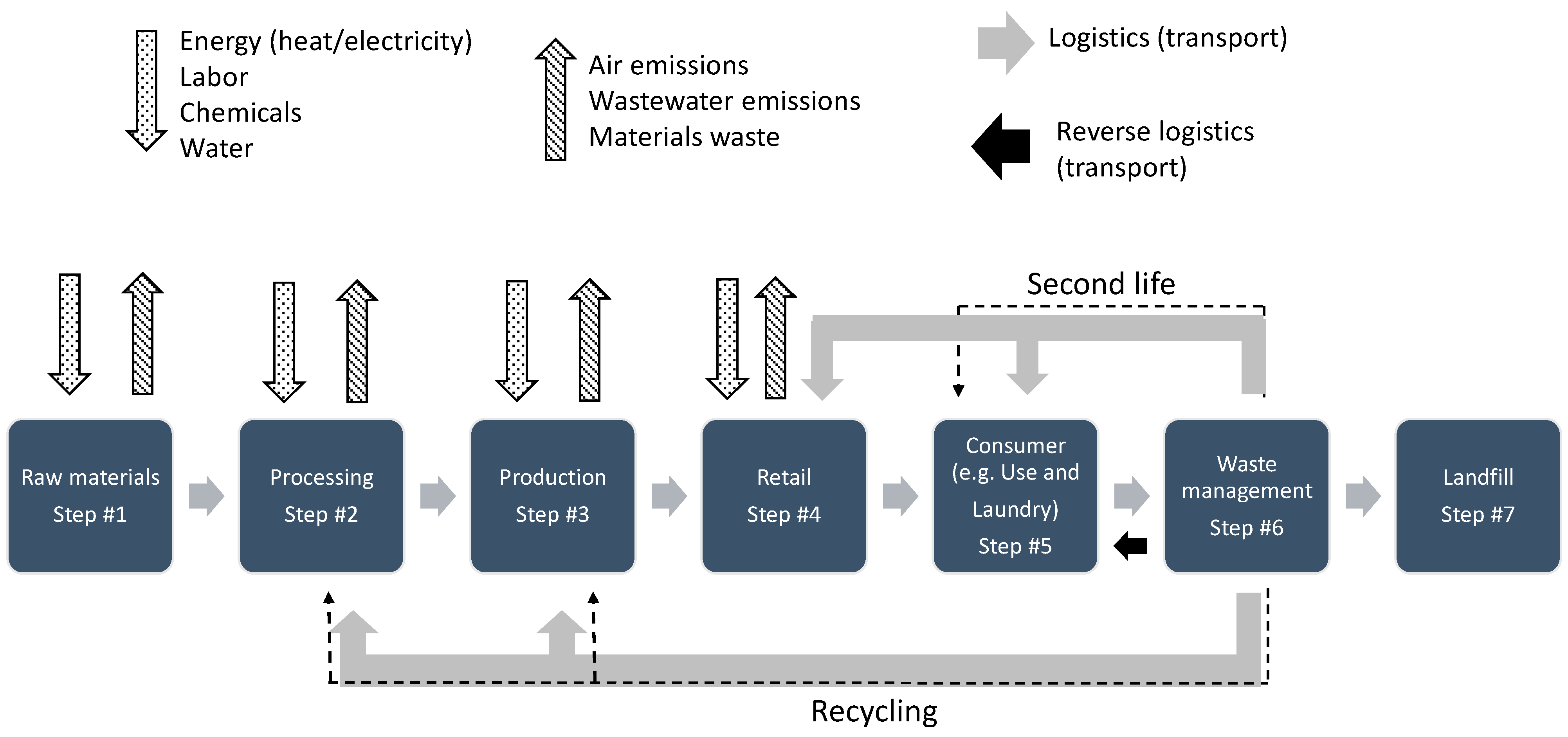

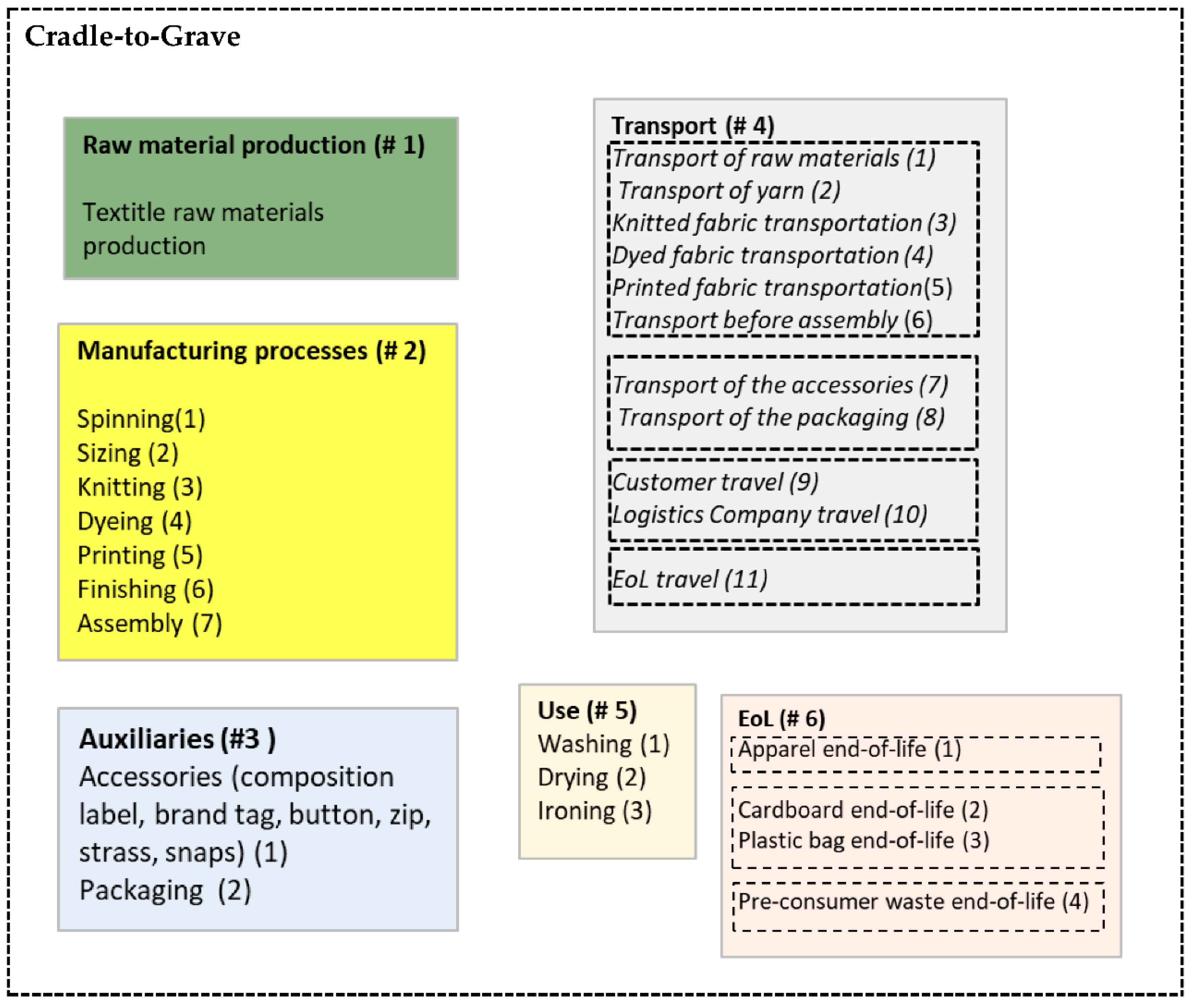


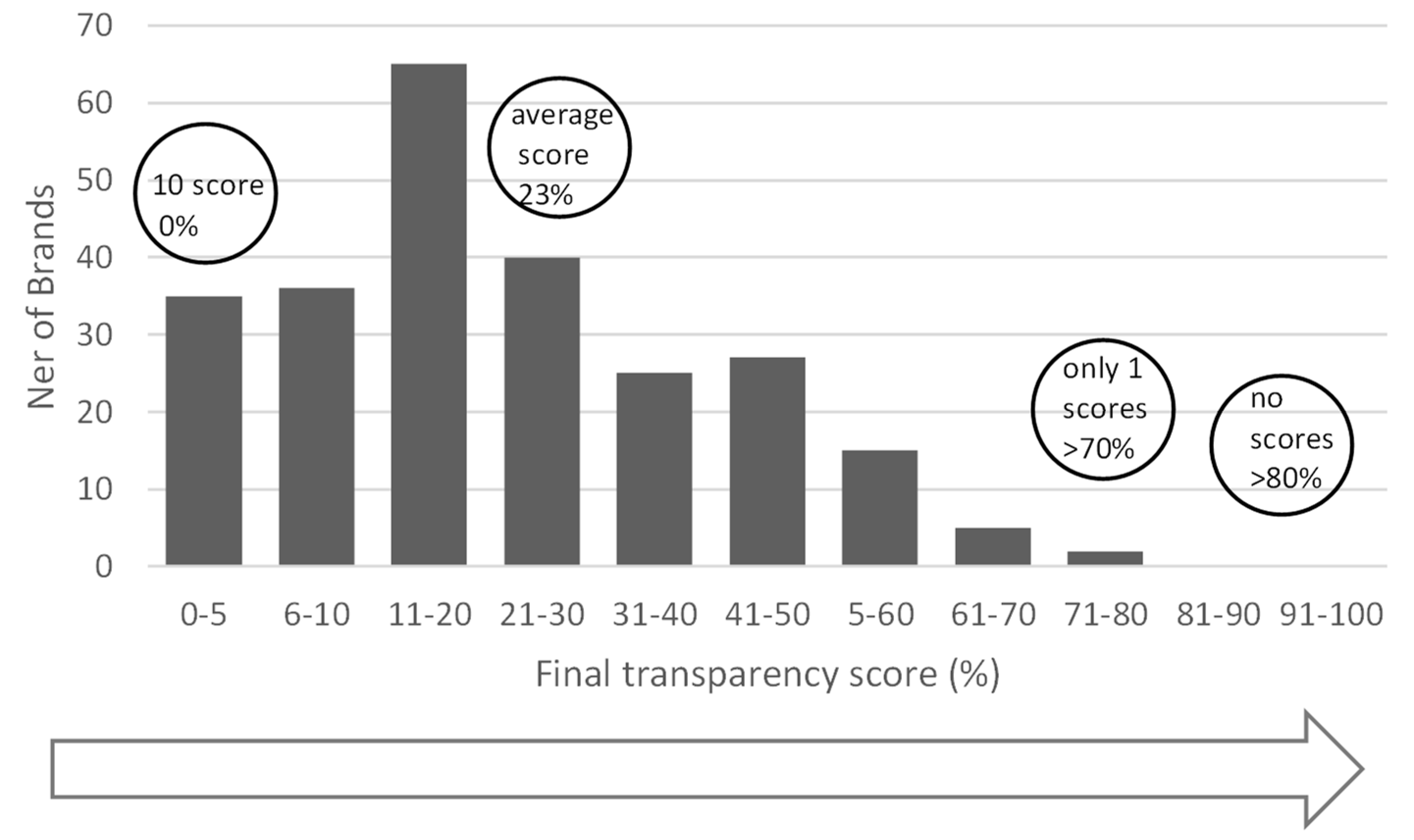

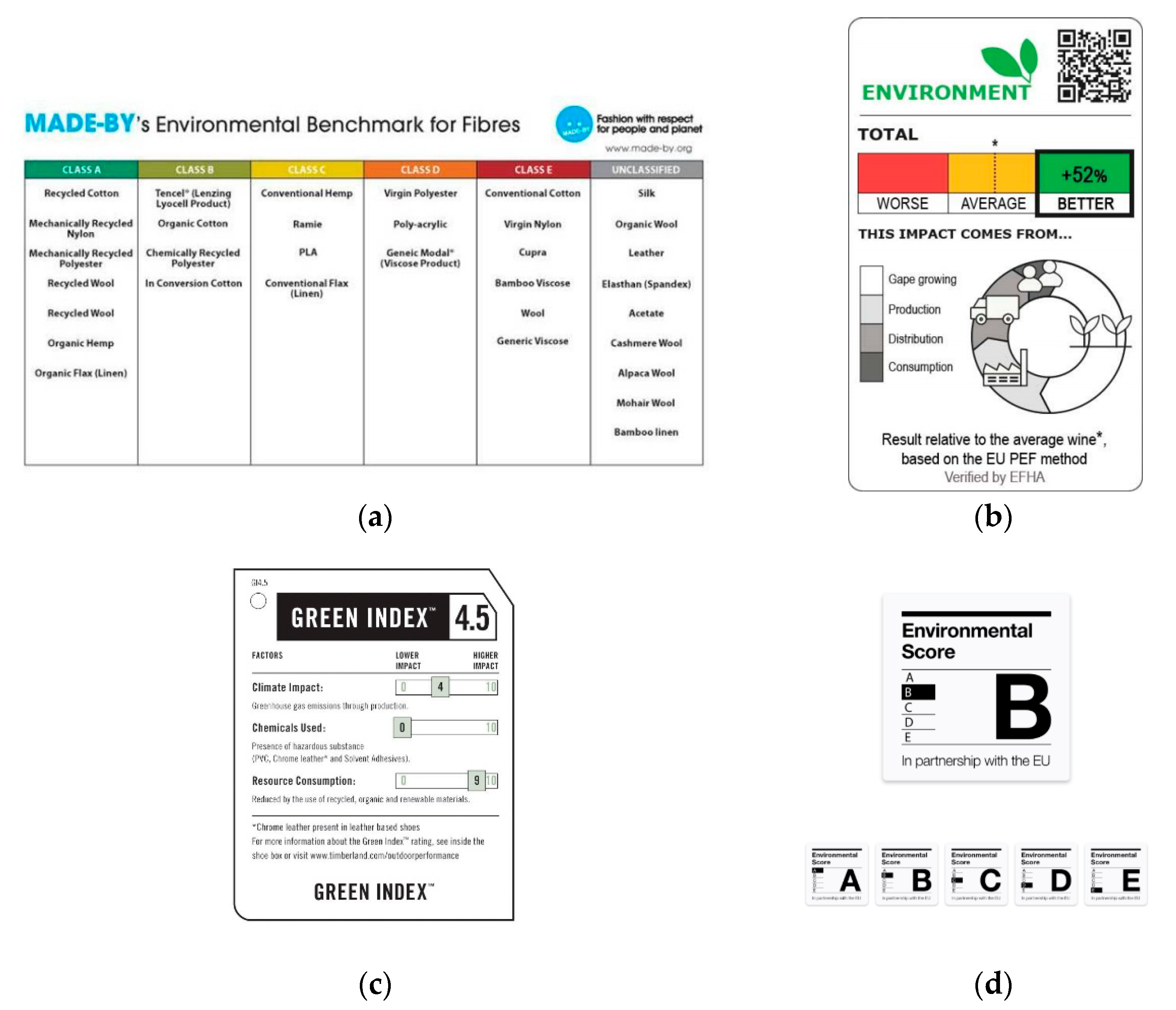
| Supply-Chain Jeans | Category | Indicator | Eco-Costs (€/Jeans) |
|---|---|---|---|
| Env | Human toxicity | 0.04 | |
| China-India-Bangladesh | Ecotoxicity | 0.14 | |
| Resource depletion | 0.21 | ||
| Carbon footprint | 0.28 | ||
| Social | MAW | 1.918 | |
| EP | 0 | ||
| OSH | 0.755 | ||
| Env + social | Total | 0.67 + 2.674 | |
| India-Bangladesh-Bangladesh | Env | Human toxicity | 0.04 |
| Ecotoxicity | 0.18 | ||
| Resource depletion | 0.21 | ||
| Carbon footprint | 0.31 | ||
| Social | MAW | 0.135 | |
| EP | 11.668 | ||
| OSH | 0.759 | ||
| Env + social | Total | 0.74 + 12.561 | |
| USA-Belgium-Belgium | Env | Human toxicity | 0.08 |
| Ecotoxicity | 0.34 | ||
| Resource depletion | 0.54 | ||
| Carbon footprint | 0.82 | ||
| Social | MAW | 0 | |
| EP | 0 | ||
| OSH | 0.384 | ||
| Env + social | Total | 1.78 + 0.384 |
| Ethical Trading Initiative [50] | Amfori BSCI [51] | SMETA 2 Pillars (Sedex) [52] |
|---|---|---|
| Employment is freely chosen | The rights of Freedom of Association and Collective Bargaining | Universal Rights covering UNGP |
| Freedom of association | No Discrimination | Management Systems and Code Implementation |
| Working conditions are safe and hygienic | Fair Remuneration | Freely chosen employment |
| Children Labor shall not be used | Decent Working Hours | Freedom of Association |
| Living wages are paid | Occupational Health and Safety | Health and Safety |
| Working hours are not excessive | No Child Labor | Child Labor and Young Workers |
| No discrimination is practiced | Special Protection for Young Workers | Wages and Benefits |
| Regular employment is provided | No Precarious Employment | Working Hours |
| No harsh or unhuman treatment is allowed | No Bonded Labor | Discrimination |
| Protection of the Environment | Regular Employment | |
| Ethical Business Behavior | Sub-Contracting and Homeworking | |
| Harsh or Inhumane Treatment | ||
| Entitlement to Work | ||
| Environment |
| Higg Product Tools | Higg Facility Tools | Higg Brand and Retail Module |
|---|---|---|
| Higg Materials Sustainability Index (MSI) Inputs Energy Water Materials and Chemicals Agricultural Land Outputs Product (intermediate output) Solid waste Emissions Wastewater Or Climate Change Eutrophication Abiotic Resource depletion-Fossil Fuels Water Scarcity Land use * Human Toxicity * Ecotoxicity * | Higg Facility Social and Labor Module Recruitment and Hiring, Working Hours, Wages and Benefits, Employee Treatment Employee Involvement Health and Safety Termination Management Systems Facility workforce standards and those of value chain partners External engagement on social and labor issues with other facilities or organization Community engagement. | Forced Labor or Human Trafficking Child Labor Wages and Benefits Working Hours Freedom of Association and Collective Bargaining Health and Safety Access to Water and Sanitation Decent Work Discrimination, Harassment, and AbuseSexual Harassment and Gender-Based Violence Bribery and Corruption Right to Health Right to Privacy Right to Security of the Person Minorities’ and Communities’ Rights Land Rights |
| Higg Product Module Product type Product category Bill of Materials Material production processes Materials in trims/components Packaging (retail store or to ship to consumer) Tier 1 production process | Higg Facility Environmental model Environmental Management systems. Energy use and Greenhouse Emissions Water Use Wastewater Emissions to Air (if applicable) Waste Management Chemical Use and Management | Animal Welfare Biodiversity/Land Use/ Habitat loss Deforestation, Energy/Fuel Use Greenhouse Gas (GHG) Emissions Air Emissions/Air Pollution (non GHG) Solid Waste Hazardous waste Chemical Hazard/Management Water use/water scarcity Wastewater/Water pollution Eutrophication |
| Social | % of the Selected Top 10 Retailers |
|---|---|
| Social Responsibility Policy | 100% |
| Training and Education | 100% |
| Health and Safety Initiative | 100% |
| Non-Discrimination Initiative | 100% |
| Women initiative | 60% |
| Modern Slavery Initiative | 30% |
| Data Protection initiative | 30% |
| Living wage/ wellbeing initiatives | 40% |
| Volunteer initiatives | 70% |
| Philanthropy/charity/donations | 90% |
| Suppliers Facilities rated | 50% |
Publisher’s Note: MDPI stays neutral with regard to jurisdictional claims in published maps and institutional affiliations. |
© 2021 by the authors. Licensee MDPI, Basel, Switzerland. This article is an open access article distributed under the terms and conditions of the Creative Commons Attribution (CC BY) license (https://creativecommons.org/licenses/by/4.0/).
Share and Cite
Gonçalves, A.; Silva, C. Looking for Sustainability Scoring in Apparel: A Review on Environmental Footprint, Social Impacts and Transparency. Energies 2021, 14, 3032. https://doi.org/10.3390/en14113032
Gonçalves A, Silva C. Looking for Sustainability Scoring in Apparel: A Review on Environmental Footprint, Social Impacts and Transparency. Energies. 2021; 14(11):3032. https://doi.org/10.3390/en14113032
Chicago/Turabian StyleGonçalves, Anabela, and Carla Silva. 2021. "Looking for Sustainability Scoring in Apparel: A Review on Environmental Footprint, Social Impacts and Transparency" Energies 14, no. 11: 3032. https://doi.org/10.3390/en14113032






